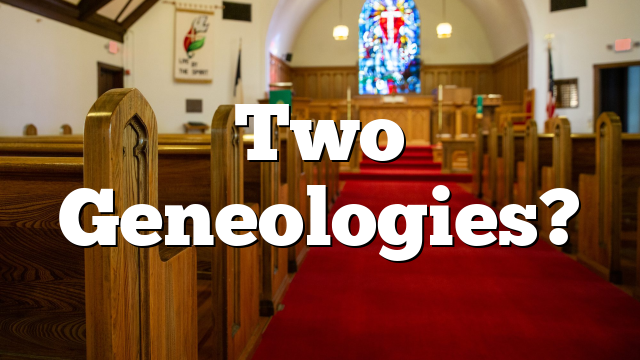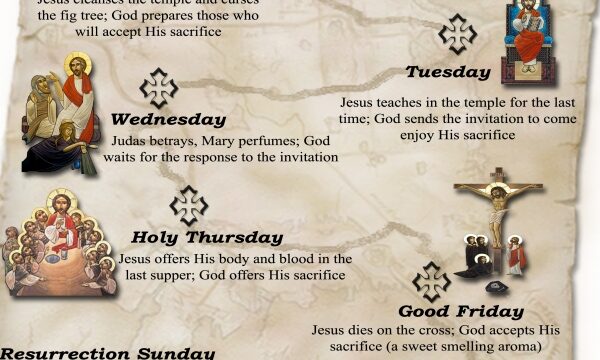Click to join the conversation with over 500,000 Pentecostal believers and scholars
Click to get our FREE MOBILE APP and stay connected
| PentecostalTheology.com



Two Geneologies?
The fist century explanation of Christ’s two different genealogies is a levirate marriage, the law decreeing that a widow should, or in rare cases must, marry her dead husband’s brother. The term comes from the Latin levir, meaning “husband’s brother.” The “brother” may be a biological sibling of the deceased or a person who is socially classified as such.
Heli and Jacob were half brothers, different fathers but the same mother. The older brother Heli died childless. The younger brother, Jacob married the widow and begat a son who is the legal son of Heli. That is why Matthew can truthfully say, Matthan begat Jacob and Jacob begat Joseph. While Luke can truthfully say Joseph, which was the son of Heli, which was the son of Matthat.
The two genealogies divide at David. The line of Jacob goes back yo Solomon. The line of Heli goes back to David’s Son, Nathan.
A more modern explanation is that Luke traces Mary’s genealogy. This is wrong according to early Christian writings as Mary’s father’s name was Joachim.
How Do Two Geneologies of Jesus Fulfill Prophesy?
The two genealogies of Jesus in Matthew and Luke divide at David. The line of Jacob goes back to Solomon. The line of Heli goes back to David’s Son, Nathan. This is an important fulfillment of Bible prophecy. It shows that Jesus is the legitimate heir to David’s throne through Solomon (I Kings 9:5) while also canceling out the curse of Jeconiah’s line (Jeremiah 22:30) through Nathan. God thought of everything.
The first century explanation of Christ’s two different genealogies is a levirate marriage, the law decreeing that a widow should, or in rare cases, must marry her dead husband’s brother. The term comes from the Latin levir, meaning “husband’s brother.” The “brother” may be a biological sibling of the deceased or a person who is socially classified as such.
Heli and Jacob were half brothers, different fathers, but the same mother. The older brother Heli died childless. The younger brother, Jacob, married the widow and begat a son who is the legal son of Heli. That is why Matthew can truthfully say Matthan begat Jacob and Jacob begat Joseph. While Luke can truthfully say Joseph, which was the son of Heli, which was the son of Matthat.
A more modern explanation is that Luke traces Mary’s genealogy. This is wrong according to early Christian writings as Mary’s father’s name was Joachim, not Heli or Jacob. There are no geneologies in scripture reckoned through the mother.



Anonymous
lets talk about this one MORE more more Michael Chauncey
I may have a special revelation on this John Mushenhouse
lets go far beyond the 5 women in it
beyond the 14×3=40 MOT 42 – as 2 are repeated
40 times the number 40 in the BIBLE always indicates something NEW
lets admit one the mother is not from JUDAH but also a Levite (as her cousin Elizabeth was too) AND her husband Joseph a Levite from Levites
lets go deep on this here revelation
NOT by chance the NT starts with 40 names + 5 of women…
NOT by chance
Anonymous
give us the scoop here Michael Chauncey John Mushenhouse Duane L Burgess
Anonymous
Troy Day Early Christian tradition says that Mary is the daughter of Joachim and Anna, both from the tribe of Judah. She is the cousin of Elizabeth, who along with her husband Zachariah were Levites.
This can be easily harmonized if Mary’s relation to Elizabeth was on her mother’s side of the family. The biblical text does not give us enough to go on to conclusively affirm which tribe Mary is from.
Anonymous
Michael Chauncey read the Luke genealogy who places Mary as a Levite 🙂
Anonymous
Troy Day verse please?
Anonymous
Michael Chauncey Elizabeth was Mary’s cousin:
Luke 1:36 And, behold, thy cousin Elisabeth, she hath also conceived a son in her old age: and this is the sixth month with her, who was called barren.
Elizabeth was a Levite:
Luke 1:5 There was in the days of Herod, the king of Judaea, a certain priest named Zacharias, of the course of Abia: and his wife was of the daughters of Aaron, and her name was Elisabeth.
Since Mary was Elizabeth’s cousin, and Elizabeth was a Levite, does that make Mary a Levite? The answer is, YES
Zachariah would have not married outside of LEVI
They were not allowed to possess LAND
Outside of LEVI his wife would have possessed land…
Anonymous
Troy Day was Elizabeth’s paternal or maternal cousin?
My paternal grandparents were French and Italian. My paternal grandparents were Enhlish and Native American.
Early Christian tradition says Mary’s father, Joachim was of Judah but her mother Anna was a Levite related to Zachariah and Elizabeth.
I realize early Christian writings are not equal to scripture in authority but hold a lot of details not included in the four gospels.
Anonymous
Michael Chauncey The other main way of harmonizing the two genealogies was first proposed by Annius of Viterbo in 1490, that Matthew gives the genealogy of Joseph, whereas Luke traces the genealogy of Mary (nicely defended by Norval Geldenhuys, Commentary on the Gospel of Luke, [Eerdmans], pp. 151-152). This view argues that when Luke says that Jesus was “supposedly” the son of Joseph, he intends then to trace Jesus’ descent through Mary, whose father was Eli. It is argued that since Luke has already described the virgin birth of Jesus (1:26-38), it is natural for him to list Jesus’ physical descent through her, alerting his readers by the word “supposedly.” Of what value would the genealogy of a supposed father be? Mary is not named in 3:23 because women were not normally listed in either Roman or Jewish genealogies. Also, since Mary seems to be Luke’s source for much of his material on the early years of Jesus, and since the Jewish genealogical records were well preserved, especially among families of Davidic descent, it would be natural for Mary to supply these records to Luke.
Anonymous
Elizabeth’s mother being a Levite is confirmed in Luke 1:5 which tells that she was “of the daughters of Aaron.”
Mary’s father was from the tribe of Judah, and he was not required to marry within his tribe. Therefore, his wife could have been from the tribe of Levite and could have been Elizabeth’s sister .Mary is said to descend on her father’s side from the tribe of Judah, and on her mother’s from the tribe of Levi.
https://www.catholic.com/qa/which-tribe-of-israel-was-marys-tribe
Anonymous
since they BOTH descended from DAVID
how could they be Levites ? Michael Chauncey
Only via Mary’s mother from the levites …
Anonymous
no throne from Joseph who was NOT HIS father…
Anonymous
The other main way of harmonizing the two genealogies was first proposed by Annius of Viterbo in 1490, that Matthew gives the genealogy of Joseph, whereas Luke traces the genealogy of Mary (nicely defended by Norval Geldenhuys, Commentary on the Gospel of Luke, [Eerdmans], pp. 151-152). This view argues that when Luke says that Jesus was “supposedly” the son of Joseph, he intends then to trace Jesus’ descent through Mary, whose father was Eli. It is argued that since Luke has already described the virgin birth of Jesus (1:26-38), it is natural for him to list Jesus’ physical descent through her, alerting his readers by the word “supposedly.” Of what value would the genealogy of a supposed father be? Mary is not named in 3:23 because women were not normally listed in either Roman or Jewish genealogies. Also, since Mary seems to be Luke’s source for much of his material on the early years of Jesus, and since the Jewish genealogical records were well preserved, especially among families of Davidic descent, it would be natural for Mary to supply these records to Luke.
Anonymous
https://www.khouse.org/articles/2020/1403/
Anonymous
back in the summer of 1993 Michael Chauncey I spent 3 months studding Mat 1 1-17 After translating the 40names there it was obvious they were distinctly grouped in 3 groups with the meanings of their names describing steps in our Christian living John Mushenhouse MIND YOU one of the middle-14 group’s name is translated as RAPTURED 🙂